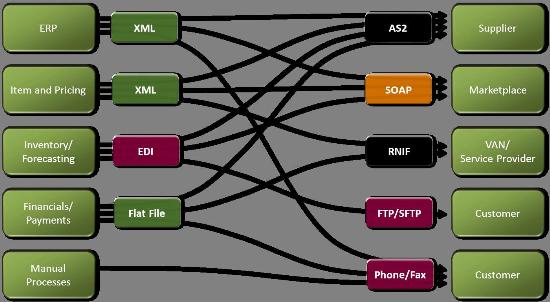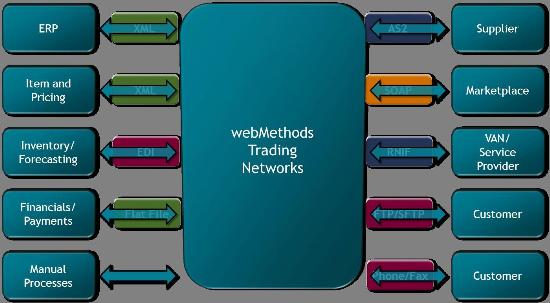In-Depth
9 Reasons to Consolidate Your B2B Systems
How B2B processes became so complex and why IT should consolidate them.
By Navdeep Sidhu, Director of Product Marketing, Software AG
Supply-chain complexity has increased greatly in the last few decades, leading to a surge in the volume of documents being exchanged electronically between companies and their suppliers and buyers. This has resulted in an increase in the number of B2B systems used by companies to handle B2B transactions.
On average, a modern mid- to large-sized company utilizes three to six separate B2B systems today to support multiple document standards and protocols. The larger the organization, the greater the number of systems and the higher the cost and complexity to maintain them. The situation is complicated even further after mergers and acquisition.
The challenges of having multiple B2B systems all come down to one critical factor: cost. Decreased efficiency, ongoing maintenance and/or upgrades of multiple systems, security breaches, lack of integration and scrambling to meet varied requirements can be expensive.
Let’s look at a few of the reasons B2B process have become so complex.
A changing marketplace: To keep pace with increasingly complex supply chains, B2B systems have had to change and grow rapidly. Although many systems are up to the task, many are inflexible and difficult to scale. At the same time, the importance and scrutiny of security, audits, and compliance have increased. In a multiple-system environment, even the slightest changes to policies, protocol, or technology can quickly become a nightmare to manage.
Keeping every plate spinning: The relevance and effectiveness of each system has come to rely on the diligence of those maintaining it as well as those who created it. Keeping systems current is a challenge that increases exponentially with each system in use, especially with many proprietary point-to-point systems, which require a dedicated set of skills and expertise to manage. Some systems are older and less efficient. Some are outdated or going out of support.
Organizations also face the modernization challenge for their legacy B2B systems, including mainframe electronic data interchange (EDI) systems, EDI translators, point-to-point integration solutions, and dependencies on value added networks (VANs) that can be expensive because they charge by message volume passing through.
Seeing outside the black box: Multiple, siloed B2B solutions that don’t provide visibility into B2B transactions increase operating costs, lower satisfaction among partners, and create higher barriers to supporting business initiatives. They also make uncovering vendor or partner redundancies difficult.
Not playing well with others: Some legacy systems are poorly integrated, lacking the ability to seamlessly co-exist with internal operations. This creates a potential point of failure for each system connected to an internal infrastructure and slows down business dramatically.
Multiple-choice hacking: As with sub-par integration, from a security standpoint, each system becomes another entry point for hacker intrusion -- especially with older legacy B2B systems. In essence, multi-system environments leave organizations only as secure as their weakest B2B system.
Wasted time and lack of agility: A multi-system B2B environment can be inefficient, from the tedious installation process that requires entering information on multiple vendors or partners in separate systems to inflexible systems that lead to an inability to respond to business demands.

Figure 1: Typical data traffic before consolidation.
Using multiple systems to support different
document standards and transport protocols
increases complexity.
The Best Path Forward: 9 Reasons to Consolidate B2B
It’s not difficult to see how a multi-system B2B environment can hold an organization back and create costly problems. How can you face such challenges head-on and keep your business moving forward efficiently and cost effectively?
Increasingly, many organizations find the answer lies in consolidated B2B gateway software built on a flexible, scalable foundation.
By moving to a single, integrated system backed by a purpose-built, solid architecture, organizations can:
1. Gain greater visibility and insight into their B2B transactions, freeing IT resources to support additional supply-chain initiatives
2. Consolidate and standardize multiple B2B projects (often resulting from siloed organizations or mergers and acquisitions) across the enterprise into a single B2B platform, enabling re-use and reducing cost
3. Minimize supply-chain disruptions and speed up business
4. Capture significant business value with increased operational and competitive agility
5. Eliminate the extra hardware and software licenses and maintenance fees that come with maintaining multiple B2B systems
6. Lower the cost of support, upgrades and system replacement
7. Work more securely and meet compliance requirements with a single point of entry for all B2B transactions
8. Better manage return on investment (ROI), total cost of ownership (TCO), and internal and external audits
9. Easily scale operations up or down with little to no downtime
With flexibility and easy integration, a comprehensive B2B gateway enables organizations to retake control of many disparate B2B systems and obtain a single view of business across all system and information silos both inside and outside the enterprise.

Figure 2: Data traffic after consolidation. B2B gateways
simplify B2B by supporting all major document standards
and transport protocols.
The Right Approach: Pain-Free Consolidation with a Service Oriented B2B Gateway
The goal is to build and maintain a single B2B gateway for all your transactions with suppliers, distributors, customers, and other trading partners of any size.
An SOA-enabled B2B gateway enables strong visibility and data management -- empowering organizations to quickly identify and extract services from the various integrated systems. In addition to fast, accurate information exchange with trading partner applications and databases, an SOA-enabled gateway also gives organizations the agility needed for service re-use and improvement versus flat-out replacement.
The result is a critical value-added capability on top of the integration with easier B2B consolidation, greater business value, and tighter integration while enabling organizations to build new services as needed and manage them across stakeholders and for their entire lifecycle.
Some examples of this impact include:
- Quickly and efficiently developing new solutions while extending existing IT investments by re-using or replacing as many or as few parts of legacy B2B services as possible, such as building a new visibility service on top of an existing translation service
- Obtaining a single view of business across all system and information silos both inside and outside the enterprise
- Taking advantage of the various options for connecting B2B services to different parts of the organization, including service-oriented, event-driven or enterprise application integration
In a nutshell, B2B is here to stay and the standards and protocols used for B2B transactions are going to further evolve and will continue to add complexity to B2B. Managing multiple B2B systems to handle various B2B standards is a thing of the past and consolidation into a B2B Gateway is the way to go. Picking an SOA-enabled B2B Gateway to consolidate your B2B is a step in the right direction. It will not only reduce your cost per transaction but also guarantee compliance with the standards of the future.
Navdeep Sidhu is director, product marketing at Software AG, where he focuses on the B2B and Managed File Transfer (MFT) areas. He has 15 years of experience in the IT industry, including background in B2B gateways and partner community management as well as managing large-scale application development and integration projects. He can be reached at [email protected].